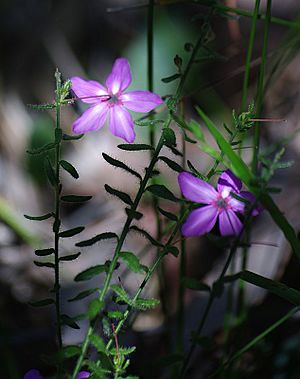Tetratheca hirsuta facts for kids
Quick facts for kids Tetratheca hirsuta |
|
|---|---|
 |
|
| Scientific classification | |
| Genus: |
Tetratheca
|
| Species: |
hirsuta
|
| Synonyms | |
|
|
Tetratheca hirsuta, often called black-eyed Susan, is a small shrub. It belongs to the plant family Elaeocarpaceae. This plant is special because it is endemic to the south-west of Western Australia. This means it only grows naturally in that area. It's important to know that this "black-eyed Susan" is not related to other plants around the world that share the same common name.
Contents
What it Looks Like
Tetratheca hirsuta is a shrub that grows upright, sometimes even climbing. It can reach a height of about 0.1 to 0.9 meters (which is about 4 to 36 inches).
Stems and Leaves
This plant has a strong, woody base underground called a rootstock. Many rough stems grow from this base. The upper parts of these stems are usually hairy. Its green leaves are also hairy. They can grow in different ways: sometimes they are opposite each other, sometimes they alternate along the stem, and sometimes they grow in circles called whorls. The leaves are small, measuring about 0.5 to 2.5 centimeters (0.2 to 1 inch) long and 0.5 to 1 centimeter (0.2 to 0.4 inches) wide.
Flowers
Beautiful pink flowers bloom on the plant between July and December in its natural home. These flowers grow on stalks that are about 3 centimeters (1.2 inches) long. Each flower is about 2 centimeters (0.8 inches) across. They have five petals that are a deep pink or sometimes have a purple tint.
Plant History
The Tetratheca hirsuta was first officially described in 1839. An English botanist named John Lindley wrote about it in his book, A sketch of the vegetation of the Swan River colony .
What the Name Means
The second part of its scientific name, hirsuta, comes from a Latin word that means "hairy." This makes sense because the plant has hairy stems and leaves! The first part of the name, Tetratheca, comes from Ancient Greek words. Tetra means "four," and theke means "sac" or "box." This name refers to the plant's anthers, which are parts of the flower that hold pollen. They have four small compartments, like four little boxes.
Where it Grows
You can find Tetratheca hirsuta in the southwestern part of Western Australia. It grows in areas with gravelly soils that come from a type of rock called laterite. It likes to grow in open woodlands and heathlands in the Darling, Avon, and western Eyre regions.
Growing it Yourself
Tetratheca hirsuta was first grown in gardens in England in 1843. However, it is not a very common plant to grow in gardens today. Even so, it has good potential for gardening, especially in rock gardens.
Best Growing Conditions
If you want to grow this plant, it prefers soils that are a bit acidic. It also likes sunny spots or places that get some shade during the day. If the plant starts to look a bit tired, you can prune its stems. Cutting them back to just above the ground can help the plant grow new, fresh parts.

